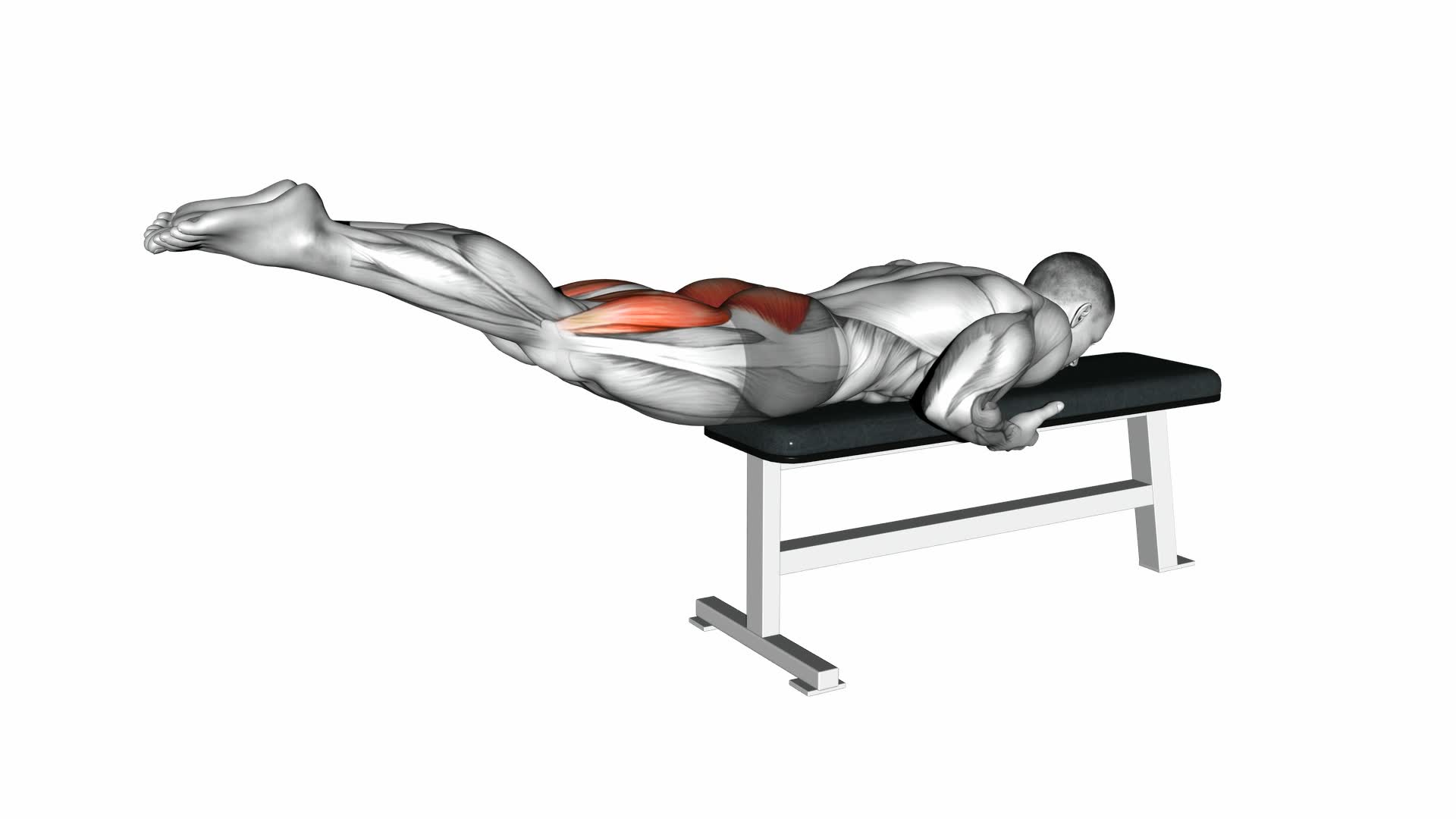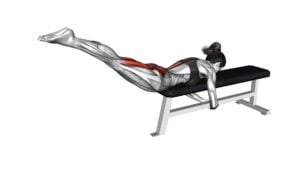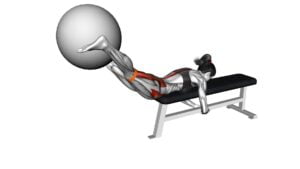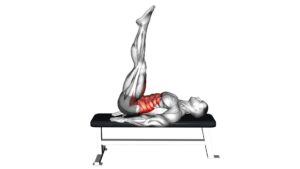Reverse Hyper on Flat Bench – Video Exercise Guide & Tips

Are you looking to level up your workout routine?
Watch This Exercise Video
In this video exercise guide, we'll show you how to do the reverse hyper on a flat bench. This powerful exercise targets your lower back, glutes, and hamstrings, helping you build strength and stability.
With proper form and technique, you can maximize the benefits and avoid common mistakes.
Get ready to take your fitness game to the next level with our video guide and helpful tips!
Key Takeaways
- Reverse Hyper is a beneficial exercise for improving strength and muscular development.
- It specifically targets the lower back, glutes, and hamstrings, providing muscular activation in these areas.
- Proper form and technique, such as maintaining a neutral spine and engaging core muscles, are crucial for effective execution.
- Variations and modifications, such as using a stability ball or incorporating resistance, can be made to accommodate different fitness levels and increase the intensity of the exercise.
Benefits of the Reverse Hyper
You can experience significant improvements in strength and muscular development with the Reverse Hyper. This exercise specifically targets the muscles in your lower back, glutes, and hamstrings, providing muscular activation in these areas. By incorporating the Reverse Hyper into your workout routine, you can strengthen and tone these muscle groups, leading to enhanced overall strength and stability.
One of the key benefits of the Reverse Hyper is improved lower back health. This exercise helps to strengthen the muscles in your lower back, which can help alleviate discomfort and reduce the risk of injury. The Reverse Hyper also promotes proper spinal alignment, which is crucial for maintaining a healthy back.
In addition to the muscular activation and improved lower back health, the Reverse Hyper can also enhance your overall athletic performance. By targeting and strengthening the muscles in your posterior chain, including your glutes and hamstrings, you can improve your power, speed, and agility.
To ensure you get the most out of the Reverse Hyper, it's important to maintain proper form and technique. By following the correct form, you can maximize the benefits of this exercise while minimizing the risk of injury.
Proper Form and Technique
Maintaining proper form and technique is essential when performing the Reverse Hyper on a flat bench, as it ensures optimal results and reduces the risk of injury. To start, make sure your body is properly positioned on the bench. Lie face down with your hips and stomach supported by the bench and your legs hanging off the edge. Keep your upper body relaxed and your hands gripping the sides of the bench for stability.
One common mistake to avoid is using excessive momentum to swing your legs up. Instead, focus on using the muscles in your lower back and glutes to lift your legs in a controlled manner. This will help you target the intended muscles and prevent strain or injury.
Another important aspect of proper form is maintaining a neutral spine throughout the movement. Avoid arching your back or allowing your hips to sag. Engage your core muscles to stabilize your spine and keep it in a straight line.
Modifications can be made to the Reverse Hyper on a flat bench to accommodate different fitness levels. Beginners can start by using lighter weights or even just their body weight, gradually increasing the resistance as they become more comfortable and stronger. Advanced individuals can use ankle weights or resistance bands to add extra challenge to the exercise.
Variations and Modifications
To vary the intensity of the Reverse Hyper on a flat bench, consider incorporating different variations and modifications into your routine.
There are various equipment options available for performing the reverse hyper exercise. You can use a stability ball instead of a flat bench to add an element of instability to the exercise, which will engage your core muscles even more. Another option is to use ankle weights or resistance bands to increase the resistance and make the exercise more challenging.
Incorporating the reverse hyper into a full body workout routine can be beneficial for targeting multiple muscle groups. You can perform the exercise as part of a lower body workout, focusing on strengthening your glutes, hamstrings, and lower back. Alternatively, you can include it in an overall core strengthening routine, as the reverse hyper engages your core muscles, including the abdominals and lower back.
To maximize the benefits of the reverse hyper, it's important to maintain proper form and technique throughout the exercise. Start with lighter weights or resistance and gradually increase as you become more comfortable and stronger. Remember to listen to your body and adjust the intensity as needed.
Tips for Effective Execution
For optimal execution, ensure that you're positioning your body correctly during the reverse hyper on a flat bench. Here are some tips to help you perform this exercise effectively:
- Lie face down on a flat bench with your hips positioned at the edge and your legs extended straight out behind you. Keep your toes pointed towards the floor.
- Grip the sides of the bench firmly to maintain stability throughout the movement.
- Engage your core muscles and lift your legs up towards the ceiling, using your glutes and lower back to control the movement. Make sure to keep your legs straight and avoid any swinging or jerking motions.
Common misconceptions about the reverse hyper on a flat bench include using excessive momentum or arching the back too much. Remember to focus on controlled movements and maintaining proper form to maximize the benefits of this exercise.
Equipment recommendations for the reverse hyper on a flat bench include using a comfortable and stable bench that can support your body weight. Ensure that the bench is positioned on a level surface to prevent any imbalance during the exercise.
Common Mistakes to Avoid
Avoid making the mistake of using excessive momentum or arching your back too much during the reverse hyper on a flat bench. These common mistakes can lead to injury and hinder the effectiveness of the exercise. When performing the reverse hyper, it's important to maintain control and stability throughout the movement.
One common mistake to avoid is using excessive momentum. Swinging your legs up and down forcefully may give the impression of a more intense workout, but it puts unnecessary strain on your lower back and diminishes the benefits of the exercise. Instead, focus on using controlled movements, engaging your glutes and hamstrings to lift your legs without relying on momentum.
Another mistake to avoid is arching your back too much. While it's natural for your back to arch slightly during the reverse hyper, excessive arching can strain your lower back and increase the risk of injury. To prevent this, engage your core muscles and maintain a neutral spine throughout the exercise. This will help distribute the load evenly and protect your back.
Frequently Asked Questions
How Many Sets and Reps Should I Do When Performing the Reverse Hyper on a Flat Bench?
When performing the reverse hyper on a flat bench, it's important to consider how many sets and reps you should do. To determine the ideal number, you should take into account your fitness goals and current fitness level.
Generally, it's recommended to start with 2-3 sets of 10-12 reps. This will allow you to build strength and endurance while minimizing the risk of overexertion.
Remember to focus on maintaining proper form throughout the exercise to maximize its benefits.
Can I Still Perform the Reverse Hyper on a Flat Bench if I Have Lower Back Pain?
If you're experiencing lower back pain, it's important to listen to your body and avoid exercises that aggravate it.
While the reverse hyper on a flat bench can be beneficial for strengthening your lower back, it may not be the best choice if you're in pain.
Instead, consider alternative exercises for lower back pain, such as gentle stretches or exercises that focus on core stability.
Remember to always prioritize proper form and technique to avoid further injury.
Is It Necessary to Use Additional Weights When Doing the Reverse Hyper on a Flat Bench?
No, it's not necessary to use additional weights when doing the reverse hyper on a flat bench. The exercise itself can provide enough resistance to target your glutes and hamstrings effectively.
However, if you feel that it's too easy and want to add more challenge, you can gradually increase the weights.
Keep in mind to listen to your body and make modifications for the reverse hyper if you have lower back pain to avoid exacerbating it.
Can the Reverse Hyper on a Flat Bench Help Improve My Deadlift?
Adding the reverse hyper on a flat bench to your workout routine can definitely help improve your deadlift.
This exercise targets your glutes, hamstrings, and lower back, which are all crucial for a strong deadlift.
By incorporating the reverse hyper, you can strengthen these muscles, increase your hip drive, and improve overall lifting power.
It's important to maintain proper form and technique, so be sure to watch a video guide or consult a fitness professional for guidance.
Are There Any Alternative Exercises That Can Target the Same Muscle Groups as the Reverse Hyper on a Flat Bench?
If you're looking for alternative exercises that target the same muscle groups as the reverse hyper on a flat bench, there are a few options you can try.
One option is the glute bridge, which works your glutes and hamstrings.
Another option is the bird dog exercise, which targets your lower back and glutes.
Lastly, you can try the superman exercise, which engages your lower back muscles.
These exercises can help strengthen and improve the same muscle groups as the reverse hyper on a flat bench.
Conclusion
In conclusion, the reverse hyper on a flat bench is a beneficial exercise for strengthening the lower back and glutes. By maintaining proper form and technique, you can maximize the effectiveness of this exercise.
Remember to vary the intensity and incorporate modifications to challenge your muscles further. Following these tips and avoiding common mistakes will ensure you get the most out of your reverse hyper workouts.

Author
Years ago, the spark of my life’s passion ignited in my mind the moment I stepped into the local gym for the first time. The inaugural bead of perspiration, the initial endeavor, the very first surge of endorphins, and a sense of pride that washed over me post-workout marked the beginning of my deep-seated interest in strength sports, fitness, and sports nutrition. This very curiosity blossomed rapidly into a profound fascination, propelling me to earn a Master’s degree in Physical Education from the Academy of Physical Education in Krakow, followed by a Sports Manager diploma from the Jagiellonian University. My journey of growth led me to gain more specialized qualifications, such as being a certified personal trainer with a focus on sports dietetics, a lifeguard, and an instructor for wellness and corrective gymnastics. Theoretical knowledge paired seamlessly with practical experience, reinforcing my belief that the transformation of individuals under my guidance was also a reflection of my personal growth. This belief holds true even today. Each day, I strive to push the boundaries and explore new realms. These realms gently elevate me to greater heights. The unique combination of passion for my field and the continuous quest for growth fuels my drive to break new ground.







